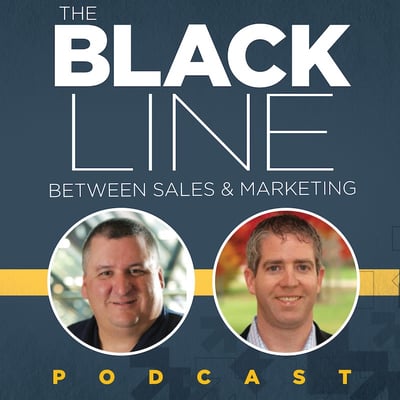It’s another day for another $2 million funding, this time from Outreach. Overall they’ve raised $488.5 million. When HubSpot when public they only raised $100 million; $35 million from debt, and that was thought of as a grand slam. Companies like Outreach and Gong raising 5 times that, is that a good thing? In this episode Mike and Doug touch on funding for private and public companies, and they dive into another report, the State of Sales 2021 for US & Canada, put out by LinkedIn.

Audio:
Show Notes

Editor's Note: If you haven't already, leave the podcast a review either on Apple Podcasts or Spotify.
We’ve done other report reviews like this in other episodes. If you would like to check them out, you can find them here:
Episode 65: MarTech 2030...The Implications
Episode 66: Gartner’s Report: The Future of Sales - What We Think
Episode 76: Under Armor, Nike & The State of Proposals 2021
BIG NEWS:
Before we get into the report review, to answer the question on whether private companies raising tons of money is a good thing, Doug would say no. According to Mike no words can explain it. Customer acquisition in the SaaS world is getting more and more expensive, so companies are having to raise more and more money. Doug doesn’t mind that they’re raising money, it’s whether it’s good that it’s happening like this in the price markets because private companies don’t meet the same standards as public markets. They don’t live up to the same threshold, and when there’s an imbalance it’s bad. You have more money coming in off of big bets and you’re betting zeros. It’s a frothy market with imbalances and Doug isn’t a fan of that.
In continuation of our ongoing series discussing state of state of state of reports, today’s report comes from LinkedIn. They released their State of Sales Report for 2021 - US & Canada edition.
Before we get into the details, here are the 7 trends they reported on:
- Virtual selling is good for sellers and even better for buyers
- Sales organizations and managers must adjust to a remote working world — now
- Sales organizations are preventing sellers from putting buyers first
- These 6 sales behaviors are killing deals
- Sales technology provides the key pathway to building trust
- For sales organizations, data is more crucial than ever
- Buyers and sellers are ramping up their use of LinkedIn
Let’s dive deeper into these.
Trend 1: Virtual selling is good for sellers and even better for buyers
Focusing on the buyers side of things, since not many people address that side, Mike’s take is that they put out a broad statement in regards to this trend. What is it that people are selling and buying? He’s not 100% sure what they mean that the process is easier, and rather thinks that the trend and statement is making a case about working from home rather than selling.
LinkedIn is trying to say here that virtual selling is here to stay. This is hard for Doug to agree with because he’s been doing this for decades. That and he hates the term “virtual selling.” It would be better as something else like distributed selling because your sellers not being all together isn’t what makes “virtual selling” different. It’s the buyer side.
There hasn’t been much about what the buy side thinks about this change. Yet, there are a few things that this change does to the buyer side. It’s harder to have side conversations in the halls or by the water cooler when you’re remote. It’s easier to avoid salespeople, and it makes it easier for them to say no to a sales offer. When something gets stalled, the salesperson can’t just show up to the business, so it’s easier for buyers to cocoon themselves.
Trend 2: Sales organizations and managers must adjust to a remote working world — now
If you asked Doug what he thought about this trend a year ago, he would say that selling was still difficult then. The big change that is happening, though, is that managing sales processes is changing. The traditional sales manager is leadership based, so their measurement of accountability was whether they saw the sales rep and if they had a good feel for what was going on.
The other element that is different is the distributed buyer environment. You can’t view the buyer activity the same because you would have 2-4 hour meets in person, but now on Zoom no one is having 2-4 hour meetings.
We have to do more self journey, and it’s a lot easier for someone on the buyer side to not be in the meeting. When things were in an office, if someone on the buyer side didn’t show up, that was your chance to grab everyone. Now they can easily skip out on meetings and it’s not looked at the same in terms of consequences of not having that one person in the meeting.
One thing we have to watch out for is that companies are going to lose some growth muscle mass. One of the problems that a lot of newer salespeople have now is that someone forgot to teach selling in the sales training because there’s so much process.
For Mike when he was reading this, the one thing that stuck out to him came down to one of the most important skills that you can learn in business — Business Acumen. It’s going to be really hard to get real life situational awareness of those conversations with people, coworkers, etc. It used to happen in the halls and in little moments throughout the day. Now it doesn’t.
Doug agrees with that and he’s right that the opportunistic side of picking things up is harder, although that’s a shift from outside sales to inside sales. It’s not necessarily new. Those big sales meetings were the culmination of a good sales process of all the footwork you did. You used to have multiple conversations with multiple people. The sales meeting wasn’t where you did the work; you did your work in between everything. The other thing that has changed is that you don’t get to ask certain questions in a first meeting now. You have to understand what the prospect does before you even get into the conversation to be able to deliver them insight.
Trend 3 (and the most insightful): Sales organizations are preventing sellers from putting buyers first
Here’s the thing, it isn’t the salesperson’s fault, it’s the process.
The report shows that “65% of sellers say they “always” put the buyer first. But only 23% of buyers agree.” Now, the quote that’s interesting is, “‘The selling process has changed to the buying process, is the best way I can put it.’” The quote is wrong because it hasn’t changed. What’s happening is a decision process until selling organizations understand what we are doing, what we are managing, what we are facilitating, what we are leading, what we are including is a decision process. Until they understand that, we’re going to keep running in circles doing something else.
The report goes on to list The Buyer First Philosophy which is:
- Learn, then define
- Share readily
- Solve, don’t sell
- Deliver value
- Earn trust
Doug doesn’t agree that share readily is a metric. Buyers don’t lack information. Buyer’s don’t lack good information. Buyers don’t lack content, and buyers don’t lack good content. The problem is that buyers are overwhelmed with conflicting information. The great seller of tomorrow is going to curate effectively.
Skipping over to page 20 of the report, LinkedIn lays out that both buyers and sellers see these behaviors as Buyer First. “82% of buyers being completely transparent about pricing.” Doug thinks that that’s a buyer first behavior. “89% of sellers think being completely transparent about pricing is a buyer first practice, and 67% say they always put the buyer first.” How transparent are people with pricing? “30% of buyers say yes, while 46% of sellers say they are.”
All the barriers to buyer first aren’t bad, it comes down to bad structure. They’re the byproduct of bad structure. They don’t lead there, they’re caused by it. We need to understand that the traditional selling process isn’t broken. It’s just bad. It delivers a consistent result. It’s not a bug; it’s a feature. The behavior isn’t the problem, they system is. We keep trying to fix it, we’re rearranging deck chairs on the titanic. Selling today is different in kind and we need to rethink the process. Every year people say sales is broken. We put a video together on the foundation for this — The Revenue Acceleration Framework.
We have to figure out where the conversation matters and adds value and then we need to enable. We use that as a negative because they aren’t thinking and being lazy and it’s a bad crutch. A good crutch enables; we need to enable the conversation and make it easier to have the conversation and focus less on the details of what to say.
Trend 5: Sales technology provides the key pathway to building trust
This makes it sound like tech does the solve, and that’s not the pathway to trust. Do you understand it better than I did? Do you have my back? Do you understand the risk involved for me? Those questions and mindset lead to trust. Teach your prospect all the places they can go wrong. Many people say not to talk about the downsides, but you should because you gain more trust with showing them that you have a plan for when those things do go wrong.
Trend 7: Buyers and sellers are ramping up their use of LinkedIn
This is the cost of the report. Doug doesn’t want to blast LinkedIn because he appreciates the report, but they have to do something about all the noise and trash there. Doug is starting to develop a probability index of the probability that if he accepts any new request that he’s going to get some “useful,” direct message back in under 20 minutes.
TAKEAWAYS:
Mike - I don’t know that I would download this. I feel like it’s a lot of regurgitation, and the killer point that was made today was on original thought. And this report doesn’t have a lot of original thought behind it.
Side note: Mike lives in an echo chamber who lives, breathes, and thinks about this stuff all the time. So while this is regurgitation for him, there’s a lot that’s new here for those that don’t think about it. You can benchmark yourself with this report and see where you can compare.
Doug - Sales isn’t broken. We have to stop saying sales is broken. It creates a non buyer first, non-value added experience. If it was broken it would be inconsistent. Let’s address the cause because in all honesty selling isn’t that hard. It’s not rocket science. The underlying structure can be complicated, but if you build the plumbing right you can put it behind walls and let it run. We’re making it harder than it has to be because we keep trying to patchwork something that’s going to do what it’s going to do.
Some of the best restaurants are that way because they structured an amazing experience. They looked at the underlying system and they designed and iterated that system. It’s not a game changer, but you will spend more time and money for dinner at those places because you’ll have one of the most exceptional experiences of your life. We can bring the same thing to sales.

 Doug Davidoff
Doug Davidoff